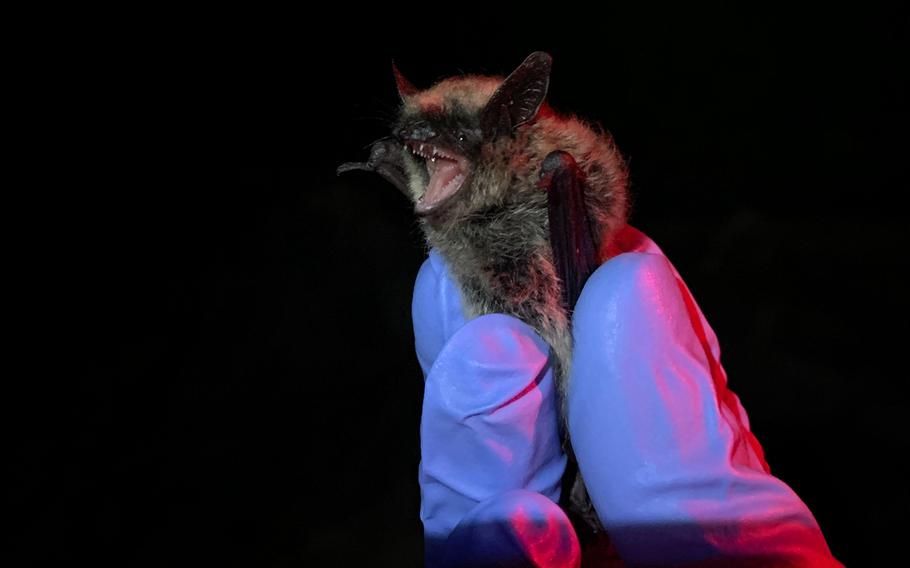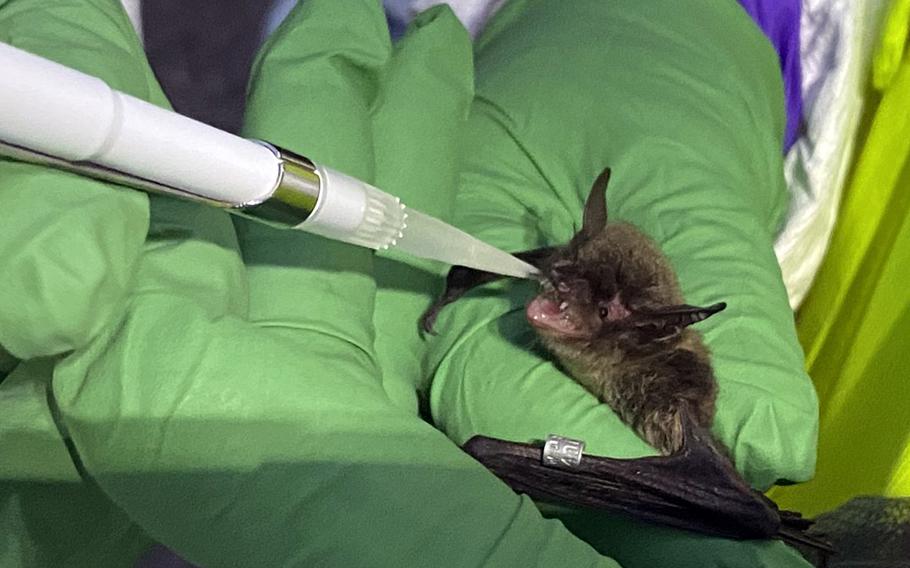
An eastern small-footed bat at the U.S. Military Academy in West Point, N.Y. The academy and the Army Corps of Engineers are teaming up to create a plan to protect bats on the historic grounds. (U.S. Army Corps of Engineers)
Bats have long been associated with Halloween, but at many U.S. domestic and overseas military installations they’re more than just a symbol of the season. They’re permanent residents that need protection.
The Defense Department has broadened efforts to keep bats out of harm’s way while ensuring that the primary tasks of training personnel and defending the country aren’t jeopardized, according to the Army Corps of Engineers, which is leading the initiative.
A drastic drop in bat numbers in parts of the United States is spurring the DOD push to safeguard the populations on its premises.
More than 300 installations stateside could have threatened or endangered bat species living on them within the next five years, according to Defense Department data. In the U.S., the DOD is bound by federal law to keep those species safe.
“Our work is important because it directly impacts on-the-ground land and natural resource management on DOD installations,” Pat Wolff, a U.S. Army Corps of Engineers biologist, said in a statement Thursday.
Bat conservation efforts are a “top priority” for the military, Wolff added.
The Army Corps of Engineers is working with the U.S. Military Academy to develop a plan to protect federally listed bat species on the historic property in New York.
Research is also being done at Camp Grayling, Mich.; Fort Cavazos, Texas; Adelphi Laboratory Center in Maryland and Fort Buchanan in Puerto Rico, reflecting the diverse ecosystems and unique challenges faced by each installation.
The Corps’ Engineer Research and Development Center has studied bats on military land for decades. Historically, it focused on assessing the potential impacts of military training on threatened or endangered species.
But researchers have since begun evaluating the statuses of bat populations on installations, which the Army Corps of Engineers has described as an “urgent need.”
Some areas in North America have seen bat populations decline by over 90% in recent years, largely due to white-nose syndrome, a fungal disease that was discovered in 2006, according to the U.S. Fish and Wildlife Service.

A bat is administered a vaccine against white-nose syndrome. Some areas in North America have seen bat populations decline by over 90% in recent years, largely because of the fungal disease. (Tonie Rocke/U. S. Geological Survey)
AI-driven software designed to identify bats by their echolocation calls is playing a key role, the Corps of Engineers said. Another project involves improving the safety and efficiency of artificial roosts, or bat boxes.
Many military installations have installed the boxes to help monitor and manage bat populations. But in some cases, poor design and bad placement have made them ineffective or even harmful, according to researchers.
“We looked at how well different bat box designs work for housing bats and tested acoustic lures to attract bats faster,” Wolff said. “We also offered guidance to help military managers use bat box technology effectively.”
The Pentagon’s bid to protect bat populations extends to some of its foreign bases as well.
In Germany, U.S. Army Garrison Rheinland-Pfalz spokeswoman Tammy Muckenfuss said Tuesday that ongoing efforts to protect bats at its Miesau Army Depot were paying off.
Since 2009, the number of bats being monitored there has jumped about 400%, according to data from the garrison.
The Miesau depot, part of the vast Kaiserslautern Military Community, is one of the Army’s largest ammunition depots outside the U.S.
In the German state of Bavaria, a 2021 project at the Army’s base in Hohenfels that transformed the apse of a former church into a bat shelter also is keeping up its effectiveness, officials there say.
“The project is still running successfully, and the number of bats remains stable,” the 7th Army Training Command said in a statement Tuesday.
“The apse was well-accepted by the bats since it was built, as it provides another space with different temperature conditions, which allows the bats to find different resting places inside the church.”
The Hohenfels Training Area is home to 19 species of bats, five of which are federally protected in Germany, Stars and Stripes reported at the time. That number includes the greater horseshoe bat, the rarest bat species in the country.